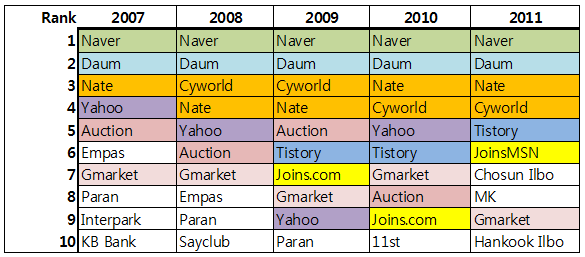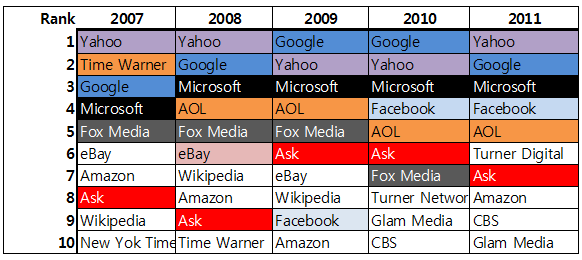
Weekly VentureSquare Stories are summaries of some of the week’s top posts relating to the Korean startup and venture Industry.
Daum TV’s Entrance into the TV Market Daum obtained rights for IPTV through OPEN IPTV in 2008. Also, Daum have had the knowledge of what digital services can offer through such services since around 2005. To expand Daum’s services from just computer and mobile into the home living room, Daum launced it’s new OTT (Over the top) setup box, DaumTV. The media describes Daum’s launch as part of the SmartTV trend because it’s easier to just put it in that same category. But to be more clear, the more appropriate category would be OTT TV, similar to Apple’s iTV and ROKU models. Users can buy the device from distributors and connect the setup box straight to their TV. The price of the box is somewhere over 150,000won and the main distributor is set to be retailer E-Mart.
Daum obtained rights for IPTV through OPEN IPTV in 2008. Also, Daum have had the knowledge of what digital services can offer through such services since around 2005. To expand Daum’s services from just computer and mobile into the home living room, Daum launced it’s new OTT (Over the top) setup box, DaumTV. The media describes Daum’s launch as part of the SmartTV trend because it’s easier to just put it in that same category. But to be more clear, the more appropriate category would be OTT TV, similar to Apple’s iTV and ROKU models. Users can buy the device from distributors and connect the setup box straight to their TV. The price of the box is somewhere over 150,000won and the main distributor is set to be retailer E-Mart.
Much talk about DaumTV was spreading through the tech and media communities before it was even launched. Some of the negative outlooks were: the “Do it Yourself” culture involved in purchasing the device and setting it up yourself was not very strong in Korea, the difficulty of integrating content, and the unavoidable influence and conflicts between media groups and communications companies.
However, the most important thing here is Daum’s positive choice to take on the TV market. The biggest strength is that they believe in being able to sell top quality setup boxes through distributors. Daum aims to provide a unique user experience rather than just follow in the footsteps of other companies. If it hadn’t been for the development team at Daum and their focus in this area, this would not have been possible. Daum is Korea’s 2nd largest portal site and it is possible for the company to earn revenue from its content. DaumTV will also utilize its other services such as its cloud storage so that users can access stored videos, search services and games.
Is Kakao Talk really a venture? – A look in to founder Beom-Soo Kim’s past
Most people know that the founder of Kakao Talk, Beom-Soo Kim is the founder of Korea’s number one game portal Hangame. After such a success, it seems that he has gone on to make another company which looks to be just as successful. Not only is it the number one messaging app but it was even mentioned by President Barack Obama during his recent speech at Hankuk University in Seoul. Kim says he was very poor as a child but made it in to Seoul University’s Industrial Engineering department. He says he had a lot of fun there which caused him to sacrifice some marks. Kim later joined a company called “Unitel”, a communications service similar to AOL which embraced a mouse interface rather then text.

At the time, Hangame was being run by about 20 people and approximately 100,000 people were joining a day. Hangame, which needed infrastructure for the traffic, and Naver which had been been looking for a large user base merged suddenly in April 2000. Even through the burst of the dot-com bubble, the company remained robust. After being a co-founder at NHN for five years, he suddenly quit after taking over the top position at NHN USA. Though there are many stories, nobody knows exactly why.
In December 2006 Kim founded Iwi Lab. His first project was a video and image sharing web 2.0 blog platform in the US which failed. Then, in 2008 he created a collective knowledge site named Wisia which also failed to do well. After this Kim judged that there was no longer a chance of doing well through the web and turned to the mobile arena. After studying app development he decided to begin his next venture in 2010. He thought that since mobile phones were designed for communication the biggest market would be in communication. On March 20th that same year he launched Kakao Talk.
Kakao Talk wasn’t a first mover. The overseas app WhatsApp and the Korean M&Talk were already on the market. However, WhatsApp wasn’t free and M&Talk had some problems. Kakao gained interested as it was free, provided good service and enabled easy group chatting. While the design and ease of use also helped its success, the group chatting feature was the winning point, especially for overseas users. It was then that the second war for mobile messengers began, with Daum’s “My People” allowing internet voice and the university venture “TicToc” solving the problem of a delay in messages. Recently Naver also entered the market with its new product “Line”. Nevertheless, Kim’s extension of Kakao Talk into the world of social networking with Kakao story managed to attract 5 million users without any marketing in just three days
Impeneterable Korean Websites vs. The American Frontline
What has been the most used site by internet users in Korea for the past five years? Naver, of course. Then have there been any changes in the other top rankings of websites? Here are the top ten sites which received the most visitors for the last five years from 2007 to 2011.
 The first three competitors are clearly an unmovable force. Apart from the top three, the remaining sites on the list are also extremely strong competitors. As you can see on the chart, 18 sites in total have been in the top ten for the last five years and the colors indicate the ranks are fairly stable. Over this time Tistory was acquired by Daum and Cyworld was acquired by Nate, hence the similar colors. Empas was also acquired by Nate but disappeared as a result.
The first three competitors are clearly an unmovable force. Apart from the top three, the remaining sites on the list are also extremely strong competitors. As you can see on the chart, 18 sites in total have been in the top ten for the last five years and the colors indicate the ranks are fairly stable. Over this time Tistory was acquired by Daum and Cyworld was acquired by Nate, hence the similar colors. Empas was also acquired by Nate but disappeared as a result.

DaumTV’s Remote Control Interface
First, let’s look at the box. It measures 10 x 10 x 10cm, it’s a similar cube shape to Boxee (18 x 18 x 17.8cm)but around as compact as the Apple TV(9.8 x 9.8 x 2.3cm) or Roku (8.4 x 8.4 x 2.3cm). Comparisons are made in the images below. DaumTV has an in-built tuner which picks up both digital and standard/cable channels. From a UI perspective this is quite an important point. Most of the time additional devices are divided from the main TV service and a change of mode is required to access it. OTT boxes are usually like that. Although, GoogleTV having partnered with Dish Network and offer an interrupted paid-TV setup box in HDMI.

The remote control adopts a style similar to Boxee with simple front controls plus a QWERTY keyboard on the back. Also, the controller uses a touch pad which was popular at the last CES. One thing that is worth taking a look is the OTP (Optical Track Page) from CrucialTec, which has also invested in DaumTV. CrucialTec is gaining a name for itself after BlackBerry adopted some of its technology and since expanding their supply chain, the company is strongly pursuing the controller solution area. Becoming part of DaumTV appears to be one of their strategies to support the company’s expansion.
OTP is in fact not that new and is a solution already being used LG and many other remote controllers. Nevertheless, if you compare it with standard trackpads which take up a lot of space, it seems more possible that designs which can be used with just one finger could be possible. The problem is finding a GUI design to match the interface. TV remotes are not so different to mobile technology. It needs to be compact, easy to use and intuitive. However, DaumTV’s OTP is quite ordinary. Most of the Navigation is not OTP but a D-pad which seems to be used to control the mouse pointer on web pages. A “flick pad” has been placed at the top for flicking. Perhaps the OTP UI cannot sense flicking? If the the OTP is mainly for just controlling the mouse, is it really needed?
Though I haven’t used it yet it looks as though Daum has tried to exclude more complicated features and focused on keeping the device simple. It’s a little disappointing that they have chosen already common and well-known solutions. I look forward to seeing some more exciting ideas in the next version.
View more photos of Daum’s new system at the original post.
Korea’s Leading Startup OpenIR and Entrepreneur Conference
- Date: May 31st (Thursday)
- Venue: Plaza Hotel, Jung-gu, Seoul
- Host: Maekyung Media Group
- Support: KTOA, VentureSquare
- Sponsors: KT, SKT, LGU+
Featuring:
- IT companies other than mobile-based will be included
- Startups which are up to five years old can apply
- Introduction of a 60 second elevator pitch
- Top Seven Startups to take part in an Upcoming Camp Event





